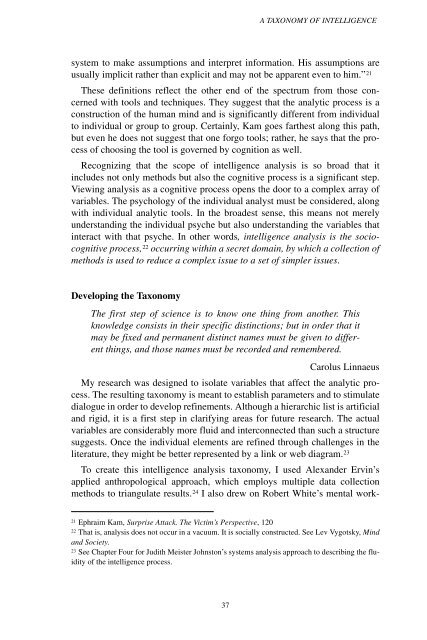Analytic Culture in the U.S. Intelligence Community (PDF) - CIA
Analytic Culture in the U.S. Intelligence Community (PDF) - CIA
Analytic Culture in the U.S. Intelligence Community (PDF) - CIA
You also want an ePaper? Increase the reach of your titles
YUMPU automatically turns print PDFs into web optimized ePapers that Google loves.
A TAXONOMY OF INTELLIGENCE<br />
system to make assumptions and <strong>in</strong>terpret <strong>in</strong>formation. His assumptions are<br />
usually implicit ra<strong>the</strong>r than explicit and may not be apparent even to him.” 21<br />
These def<strong>in</strong>itions reflect <strong>the</strong> o<strong>the</strong>r end of <strong>the</strong> spectrum from those concerned<br />
with tools and techniques. They suggest that <strong>the</strong> analytic process is a<br />
construction of <strong>the</strong> human m<strong>in</strong>d and is significantly different from <strong>in</strong>dividual<br />
to <strong>in</strong>dividual or group to group. Certa<strong>in</strong>ly, Kam goes far<strong>the</strong>st along this path,<br />
but even he does not suggest that one forgo tools; ra<strong>the</strong>r, he says that <strong>the</strong> process<br />
of choos<strong>in</strong>g <strong>the</strong> tool is governed by cognition as well.<br />
Recogniz<strong>in</strong>g that <strong>the</strong> scope of <strong>in</strong>telligence analysis is so broad that it<br />
<strong>in</strong>cludes not only methods but also <strong>the</strong> cognitive process is a significant step.<br />
View<strong>in</strong>g analysis as a cognitive process opens <strong>the</strong> door to a complex array of<br />
variables. The psychology of <strong>the</strong> <strong>in</strong>dividual analyst must be considered, along<br />
with <strong>in</strong>dividual analytic tools. In <strong>the</strong> broadest sense, this means not merely<br />
understand<strong>in</strong>g <strong>the</strong> <strong>in</strong>dividual psyche but also understand<strong>in</strong>g <strong>the</strong> variables that<br />
<strong>in</strong>teract with that psyche. In o<strong>the</strong>r words, <strong>in</strong>telligence analysis is <strong>the</strong> sociocognitive<br />
process, 22 occurr<strong>in</strong>g with<strong>in</strong> a secret doma<strong>in</strong>, by which a collection of<br />
methods is used to reduce a complex issue to a set of simpler issues.<br />
Develop<strong>in</strong>g <strong>the</strong> Taxonomy<br />
The first step of science is to know one th<strong>in</strong>g from ano<strong>the</strong>r. This<br />
knowledge consists <strong>in</strong> <strong>the</strong>ir specific dist<strong>in</strong>ctions; but <strong>in</strong> order that it<br />
may be fixed and permanent dist<strong>in</strong>ct names must be given to different<br />
th<strong>in</strong>gs, and those names must be recorded and remembered.<br />
Carolus L<strong>in</strong>naeus<br />
My research was designed to isolate variables that affect <strong>the</strong> analytic process.<br />
The result<strong>in</strong>g taxonomy is meant to establish parameters and to stimulate<br />
dialogue <strong>in</strong> order to develop ref<strong>in</strong>ements. Although a hierarchic list is artificial<br />
and rigid, it is a first step <strong>in</strong> clarify<strong>in</strong>g areas for future research. The actual<br />
variables are considerably more fluid and <strong>in</strong>terconnected than such a structure<br />
suggests. Once <strong>the</strong> <strong>in</strong>dividual elements are ref<strong>in</strong>ed through challenges <strong>in</strong> <strong>the</strong><br />
literature, <strong>the</strong>y might be better represented by a l<strong>in</strong>k or web diagram. 23<br />
To create this <strong>in</strong>telligence analysis taxonomy, I used Alexander Erv<strong>in</strong>’s<br />
applied anthropological approach, which employs multiple data collection<br />
methods to triangulate results. 24 I also drew on Robert White’s mental work-<br />
21<br />
Ephraim Kam, Surprise Attack. The Victim’s Perspective, 120<br />
22<br />
That is, analysis does not occur <strong>in</strong> a vacuum. It is socially constructed. See Lev Vygotsky, M<strong>in</strong>d<br />
and Society.<br />
23<br />
See Chapter Four for Judith Meister Johnston’s systems analysis approach to describ<strong>in</strong>g <strong>the</strong> fluidity<br />
of <strong>the</strong> <strong>in</strong>telligence process.<br />
37
















